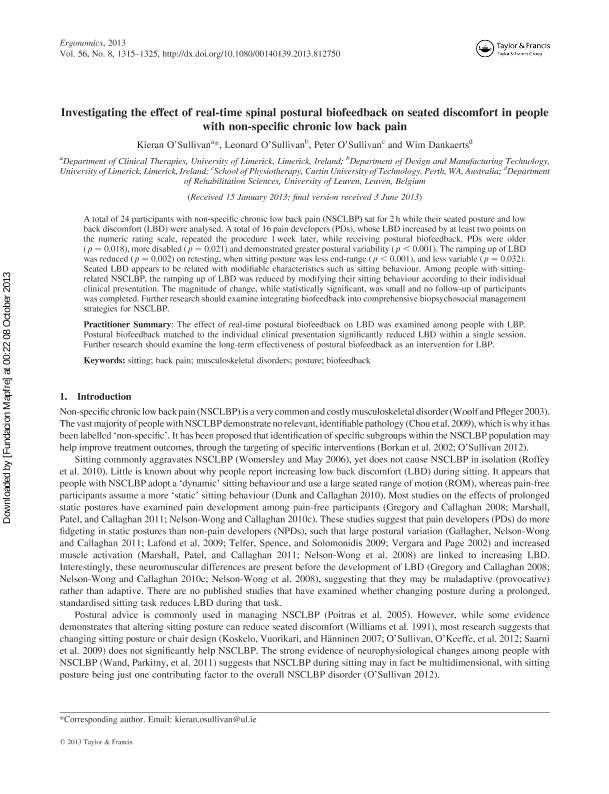Investigating the effect of real-time spinal postural biofeedback on seated discomfort in people with non-specific chronic low back pain

Contenido multimedia no disponible por derechos de autor o por acceso restringido. Contacte con la institución para más información.
| Tag | 1 | 2 | Valor |
|---|---|---|---|
| LDR | 00000cab a2200000 4500 | ||
| 001 | MAP20130032689 | ||
| 003 | MAP | ||
| 005 | 20131008170709.0 | ||
| 008 | 131008e20130805esp|||p |0|||b|spa d | ||
| 040 | $aMAP$bspa$dMAP | ||
| 084 | $a875 | ||
| 245 | 0 | 0 | $aInvestigating the effect of real-time spinal postural biofeedback on seated discomfort in people with non-specific chronic low back pain$cKieran O'Sullivan...[et.al] |
| 520 | $aA total of 24 participants with non-specific chronic low back pain (NSCLBP) sat for 2 h while their seated posture and low back discomfort (LBD) were analysed. A total of 16 pain developers (PDs), whose LBD increased by at least two points on the numeric rating scale, repeated the procedure 1 week later, while receiving postural biofeedback. PDs were older (p = 0.018), more disabled (p = 0.021) and demonstrated greater postural variability (p < 0.001). The ramping up of LBD was reduced (p = 0.002) on retesting, when sitting posture was less end-range (p < 0.001), and less variable (p = 0.032). Seated LBD appears to be related with modifiable characteristics such as sitting behaviour. Among people with sitting-related NSCLBP, the ramping up of LBD was reduced by modifying their sitting behaviour according to their individual clinical presentation. The magnitude of change, while statistically significant, was small and no follow-up of participants was completed. Further research should examine integrating biofeedback into comprehensive biopsychosocial management strategies for NSCLBP. | ||
| 773 | 0 | $wMAP20100019818$tErgonomics : the international journal of research and practice in human factors and ergonomics$dOxon [United Kingdom] : Taylor & Francis, 2010-$x0014-0139$g05/08/2013 Volumen 56 Número 8 - agosto 2013 , p. 1315-1325 |

